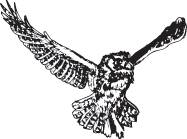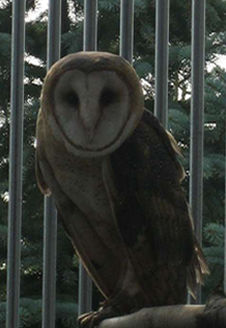

Barn Owl
(Tyto alba)
Barn Owls are very different from the other owls and belong to a different family, Tytonidae. They are the only owls with a heart-shaped facial disk, have a split talon on their third toe that is used as a comb, have relatively small dark eyes for a nocturnal animal and have long legs. Barn Owls are a medium-sized owl with worldwide distribution.
Female Barn Owls are slightly larger than males. They have a wingspan of about 41-47 inches. They are very nocturnal, rarely seen during the day unless flushed from the roost or nest. Fifty to 70 percent of young wild Barn Owls never live to their first birthday. Wild Barn Owls rarely attain the age of 10 years: the average is probably more like two to three years. Thus the turnover rate of a Barn Owl population is very rapid. The short average life expectancy is somewhat offset by the fact that a pair of Barn Owls may have two or three clutches of young per year.

A Barn Owl's habitat is open woodlands and countryside, especially grassland and farmland, often in or near towns. Small, old-fashioned farms provide perfect habitat: a mix of open fields where the owls can hunt, and hedgerows, woodlots, barns and outbuildings where they can roost and nest. Barn Owls are "restricted feeders," specializing in voles and mice. They often hunt on the wing by coursing, flying low and slow back and forth, over open fields. Average daily food intake is about 100-150 grams for adult wild birds (four to six mice).
Instead of flying in a direct line, Barn Owls tend to swing from side to side. When confronted, Barn Owls sway their lowered head from side to side. To make their defensive display scary, Barn Owls hiss and clatter their beaks. Barn Owls can really be scary by swaying back and forth, shaking their heads while hissing and bowing at the same time.
Barn Owls do not hoot. They screech -- often while flying. This rather eerie and unpleasant vocalization functions as a "song" in that it serves to claim their territory and to attract unmated females. The eerie quality of its voice has earned it nicknames like "devil's owl" and "ghost owl." Because of their eerie vocalizations and habit of nesting in abandoned buildings, Barn Owls may have been the cause of reports of haunted houses.
Barn Owls have asymmetrical outer ears. The left ear opening is below the line of sight, behind the facial disk, and looks like an upside down comma. The right ear opening is above the line of sight, tight to the edge of the facial disk, and looks like a normal comma. The results of this arrangement are that if an owl adjusts its head to receive a maximum sound in each ear, its line of "sight" will be on target.
Barn Owls are widely declining largely due to habitat loss as grassland and farmland is reduced by urbanization. Barn Owls readily use nest boxes. The only serious enemy of the Barn Owl is man. Barn Owls typically are killed by collisions with cars and overhead wires while some are killed by shooting and trapping. Great Horned Owls seem to be the Barn Owls' main natural enemy.